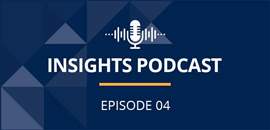- The more aggressive tightening stance by the Federal Reserve at recent FOMC meetings has altered investors’ expectations about the U.S. economy: Bond investors anticipate a slowdown while equity investors worry the Fed will over-react to inflation and trigger a recession.
- We do not expect a recession this year, but it is a close call next year if core inflation stays elevated and the Fed raises rates beyond what is currently priced into the bond market. Should a recession ensue, it is likely to be milder than the 2008-09 Global Financial Crisis (GFC) or the pandemic collapse of 2020.
- Given the uncertainty about the outlook, markets are likely to stay volatile, especially if the Russia-Ukraine conflict is prolonged. Meanwhile, we are maintaining a moderate overweight in risk assets on grounds markets have priced in higher interest rates and a soft economy.
Background: A Sea Change in Monetary Policy
Since the beginning of this year, two developments have altered the outlook for the U.S. economy and financial markets materially. One is the rise in CPI inflation to a four decade high of 8.6% and 6% for core inflation that excludes food and energy (Figure 1). The other is Russia’s invasion of Ukraine, which has boosted prices for food and energy and increased uncertainty about the global economy.

Faced with an increase in long-term inflation expectations, the Federal Reserve has turned proactive in tightening monetary policy: It raised the federal funds rate by 25 basis points, 50 basis points, and 75 basis points at the last three FOMC meetings. Moreover, it is considering another hike of 50-75 basis points at the July meeting, with further rate hikes anticipated depending on how the economy and inflation fare.
Fed officials have made clear that their overriding priority is to bring inflation under control. This stance is a dramatic change from the beginning of this year, when Fed officials expected core PCE inflation would recede to 2.7 percent by the fourth quarter. At that time, they foresaw the funds rate approaching one percent by the end of this year and two percent next year.
Now, the Fed’s latest FOMC quarterly projections show inflation is likely to stay elevated into next year. Accordingly, all 18 officials who participated expect the funds rate to be raised to at least three percent this year, with the median forecast being 3.4 percent this year and 3.8 percent next year.
The impact on financial markets was substantial in the first half of this year (see Figure 2). Treasury bond yields more than doubled, and bond yields posted negative double-digit returns for the first time in four decades. Meanwhile, the major U.S. stock market indices all sold off and are now in bear territory, with losses of 20% or more.
| STOCK MARKET | MAr. 30, 2020 - Dec. 31, 2021 | Jan. 1, 2022 - June 30, 2022 |
|---|---|---|
| U.S. (S&P 500) | 89.5 | -20.0 |
| NASDAQ | 105.9 | -29.2 |
| Russell 2000 | 98.4 | -23.4 |
| International (EAFE $) | 56.9 | -19.2 |
| Emerging Markets (MSCI $) | 51.8 | -17.6 |
| U.S. BOND MARKET | Mar. 30, 2020 - Dec. 31, 2021 | Jan. 1, 2022 - June 30, 2022 |
|---|---|---|
| Treasuries | -2.5 | -9.1 |
| IG Credit | 11.7 | -13.8 |
| High Yield | 29.1 | -14.2 |
| JPM EM Debt | 19.3 | -20.3 |
Source: Bloomberg. For informational purposes only. Frank Russell Company (FRC) is the source and owner of the Russell Index data contained or reflected in this material and all trademarks and copyrights related thereto. The presentation may contain confidential information pertaining to FRC and unauthorized use, disclosure, copying, dissemination, or redistribution is strictly prohibited. This is a Fort Washington Investment Advisors, Inc. presentation of the Russell Index data. Frank Russell Company is not responsible for the formatting or configuration of this material or for any inaccuracy in Fort Washington’s presentation thereof. You cannot invest directly in an index.
Reassessing the Economic Outlook for This Year
Consider what happened when the COVID pandemic struck in March of 2020 and businesses were shuttered. The economy and stock market plummeted, and some economists declared it would be a more severe recession than the 2008-09 Global Financial Crisis. Instead, the economy and markets rebounded quickly once businesses reopened and the government enacted unprecedented fiscal stimulus. By the time the National Bureau of Economic Research declared there was a recession, it was already over and markets had recouped most of their losses.
Viewed from this perspective, the economy is in much better shape than it was two years ago: It grew by 5.5% in 2021 while unemployment fell to a post-war low of 3.5% as the labor market tightened. However, the pace of economic activity moderated in the first half of this year as the Fed tightened policy and financial market conditions turned less accommodative (Figure 3).

The impact of Fed tightening thus far has showed up in surveys of consumer confidence and business surveys for manufacturing and non-manufacturing, which have softened (Figure 4). Interest-rate sensitive sectors such as consumer durables and housing are expected to slow as real incomes are squeezed by inflation and housing become less affordable owing to a near doubling in mortgage rates. One offset is that household balance sheets are in a good shape, and consumers are now drawing on the buildup of savings from government programs to combat the pandemic, which should bolster consumption.

Looking ahead, the Fed’s latest Summary of Economic Projections calls for growth to slow to 1.7% this year and next as inflation recedes, while the unemployment rate rises only marginally to 3.9% next year. While some observers believe the Fed’s forecast is overly optimistic, financial institutions are much better capitalized today than during the 2008 Global Financial Crisis. This lessens the risk of a credit crunch and steep economic downturn. Consequently, while corporate credit spreads have increased recently, they are still well below levels that are associated with recessions and corporate profit margins are at record levels
Therefore, our base case scenario is that the economy will not slip into recession in the balance of this year.
Looming Risks in 2023
As we peer into next year, there are several factors that could increase the risk of recession.
One that weighs heavily on equity investors is the prospect of the Fed tightening aggressively as the economy is slowing. The risk of a policy error has increased because the Fed was slow to nip inflation in the bud and it is now playing catch up so that inflation expectations do not become embedded. Federal Reserve Chair Powell acknowledged this outcome was possible in Congressional hearings, but the Fed’s base case is a soft landing.
The big unknown is the level at which interest rates will peak, as it ultimately depends on where inflation is headed. Most forecasts call for headline inflation to recede as supply-chain disruptions from the pandemic ease and goods prices moderate. However, core inflation could stay elevated at 4%-5% into next year with key components such as owner-equivalent rent set to rise. If so, the Fed would be compelled to raise the federal funds rate toward those levels so they are not negative after inflation.
How May Russia-Ukraine Conflict Impact the Economy?
The wildcard in the outlook is the Russia-Ukraine conflict, which has an important bearing on the cost of food and energy globally. Since the beginning of this year, the price of West Texas Intermediate (WTI) has increased by nearly 50% to about $110 per barrel, and some forecasts call for it to reach $125-$150 if the conflict is prolonged.
At the same time, the price of wheat has increased by 15%, and it could be headed significantly higher if Ukraine, one the largest exporter of grains in the world, is unable to ship supplies abroad. In that event the Fed would continue to focus on core inflation readings in setting policy, but large increases in food and energy prices eventually would likely filter their way into a broader array of goods.
A prolonged conflict would pose two challenges for policymakers around the world. First, it would hamper efforts to bring inflation under control. Second, it would weaken the economies of countries that import food and energy. In this respect, it would raise the specter of stagflation in which inflation stays elevated even as global growth softens.
In April, the IMF lowered its growth forecasts for advanced economies in 2023 to 2.4% from 2.6% previously. However, this occurred before the Fed raised rates aggressively and the ECB signaled it would tighten policy. Accordingly, we expect the next IMF forecast could show growth in advanced economies slowing further near or below 2% in 2023.
All told, there is a high degree of uncertainty about whether the United States will be able to avoid a recession. However, if one occurs we believe it will be shallow and relatively short.
Positioning Portfolios: Balancing Risk & Reward
In sum, in positioning portfolios we are cognizant that Fed actions to tame inflation are likely to slow the economy materially and possibly lead to a recession. However, we do not foresee a replay of the 2008 GFC or the pandemic-induced decline of 2020, because the economy is in better shape today.
We also take into account the steep sell-off in the S&P 500 and other indexes that has occurred this year, which means that valuations for stocks are more reasonable than before. Considering that the average stock market decline during recessions is 33%, we cannot rule out a further sell-off. However, downside risks are much less than at the start of the year, and investors need to have a plan for when they would redeploy cash if they choose to lighten now.
Accordingly, we are maintaining a moderate overweight to stocks over bonds in balanced portfolios. Within bond portfolios, we favor sectors such as investment grade credit, emerging market debt, and certain areas of securitized assets over U.S. Treasuries. Finally, we have recently adopted a neutral stance toward portfolio duration, as a more aggressive Fed tightening stance is priced into the bond market.
Past performance is not indicative of future results. This publication contains the current opinions of the author but not necessarily those of Fort Washington Investment Advisors, Inc. Such opinions are subject to change without notice. This publication has been distributed for informational purposes only and should not be considered as investment advice or a recommendation of any particular security, strategy, or investment product. Information and statistics contained herein have been obtained from sources believed to be reliable and are accurate to the best of our knowledge. No part of this publication may be reproduced in any form, or referred to in any other publication, without express written permission of Fort Washington Investment Advisors, Inc.






















